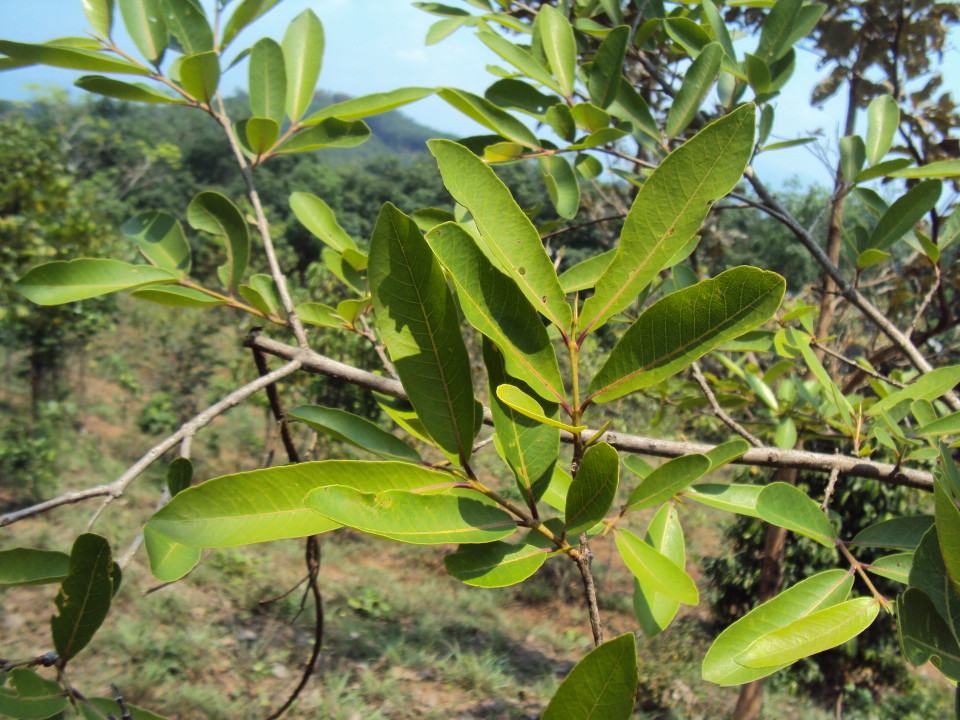
Botanical name: Terminalia arjuna, Combretaceae
Other names: Kakubha (‘mountain top’, S), Vīrataru (‘hero’s tree’ S), Arjun, Anjan, Kahu (H), Attumaratu, Nirmarutu, Vellaimarutu, Marutu (T), White Murdah (E)
Botany: Arjuna grows to become a very large tree with a huge buttressed trunk, widely spreading, drooping branches, and a grey bark that flakes off in large, flat pieces. The leaves are opposite, simple, oblong to elliptic, pale green above and pale brown below. The white flowers are borne in short axillary spikes or terminal panicles, giving way to an ovoid or oblong fruit with 5-7 short, hard wings. Arjuna is found throughout the subcontinent of India, from the foothills of the Himalayas southwards into Sri Lanka (Kirtikar & Basu 1935, Warrier et al 1996).
Part used: Stem bark.
Dravyaguṇa:
• Rasa: kaṣāya, madhura, kaṭu
• Vipāka: kaṭu
• Vīrya: śīta
• Karma: purīṣasaṃgrahaṇiya, chedana, kāsahara, svāsahara, śoṇitasthāpana, hṛdaya, mūtravirecana, aśmaribhedana, viṣaghna, medohara, sandaniya, vajīkaraṇa, kaphapittahara (Srikanthamurthy 2001, Warrier et al 1996).
Constituents: Arjuna contains a number of triterpenoid saponins (e.g. arjunetoside, arjunolitin, arjunoside I-IV, terminic acid, arjunic acid, arjunolic acid, arjungenin, termiarjunoside I/II), flavonoids (arjunone, arjunolone, luteolin), cardenolide, gallic acid, ellagic acid, oligomeric proanthocyanidins, phytosterols, tannin, calcium, magnesium, zinc, and copper (Alam et al 2008, Upadhyay et al 2001, Yadav & Rathore 2001, Yoganarasimhan 2000).
Medical research:
• In vitro: anti-HSV-2 (Cheng et al 2002), antitumor (Pettit et al 1996)
• In vivo: cardioprotective (Sumitra et al 2001); anti-oxidant (Gauthaman et al 2001); hypolipidemic, anti-atherogenic (Shaila et al 1998)
• Human trials: Twenty patients with proven coronary artery disease (CAD) were treated with an extract of Terminalia arjuna (TAE) to assess its activity. Researchers determined that TAE decreases platelet activation and may possess antithrombotic properties, suggesting its therapeutic potential in CAD and related cardiovascular disorders (Malik et al 2009). Arjuna bark given in doses of 500 mg every eight hours was associated with a significant decrease in the frequency of angina comensurate with significant improvements in exercise test parameters in male patients with chronic stable angina, without side-effects, compared to placebo and isosorbide mononitrate (Bharani et al 2002); Arjuna bark given in doses of 500 mg daily was found to promote significant reductions in total serum cholesterol, HDL, LDL, triglycerides and lipid peroxide levels in patients with coronary heart disease, compared to placebo and vitamin E (Gupta et al 2001); Arjuna given in doses of 500 mg every eight hours promoted significant improvements in left ventricular ejection fraction and a reduction in the left ventricular mass in patients with postmyocardial infarction angina and ischemic cardiomyopathy, compared to controls (Dwivedi & Jauhari 1997); Arjuna bark given in doses of 500 mg every eight hours was associated with significant improvements in signs and symptoms of heart failure in patients with refractory chronic congestive heart failure, previous myocardial infarction and peripartum cardiomyopathy (Bharani et al 1995).
Toxicity: No data found.
Indications: Dysentery, cirrhosis, bronchitis, asthma, tuberculosis, hemorrhage, leucorrhea, menorrhagia, coronary heart disease, cardiovascular disease, diabetes, cancer, broken bones.
Contraindications: Pregnancy, constipation, dryness, vātakopa.
Medicinal uses: The tree Arjuna is perhaps best known and best studied as a remedy for the heart and cardiovascular system, first introduced into the materia medica as cardiotonic by Vāgbhaṭa (c. 6-7th cent CE). For this purpose the bark is traditionally prepared as a milk decoction (kvātha), a process that appears to render the triterpenes more bioavailable (Tillotson 2001). The Aṣṭāñga Hṛdaya mentions Arjuna in the treatment of wounds, hemorrhages and ulcers, applied topically as a powder (Srikanthamurthy 1994). According to the Cakradatta, a cūrṇa of Arjuna consumed with ghṛta, milk or jaggery overcomes heart disease, chronic fever, and hemorrhaging, and promotes long life (Sharma 2002). Similarly, the Cakradatta mentions a ghṛta prepared with Arjuna, Balā, Nāgabalā and Yaṣṭimadhu as a treatment in heart disease, chest wounds, cough, pain and arthritis (Sharma 2002). In the treatment of hemoptysis, Caraka recommends equal parts Arjuna with Raktacandana, along with sugar and rice water (Nadkarni 1954). Suśruta mentions the usefulness of Arjuna as a vajīkaraṇa, combined with Candana in spermatorrhea (Nakarni 1954, 1201). Soaked in the fresh juice of Vāsaka, the Bhāvaprakāśa states that Arjuna is used in the treatment of consumption and hemoptysis (Srikanthamurthy 2000). More recently, Arjuna has gained some notoriety as a major ingredient in the patented LIV-52 formula used in the treatment of liver disorders.
Dosage:
• Cūrṇa: 3-5 g b.i.d.-t.i.d.
• Kvātha: 1:4, 30-90 mL b.i.d.-t.i.d.
• Tincture: 1:3, 50% alcohol, 3-5 mL b.i.d.-t.i.d.